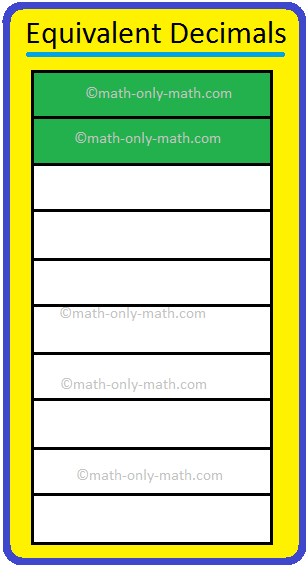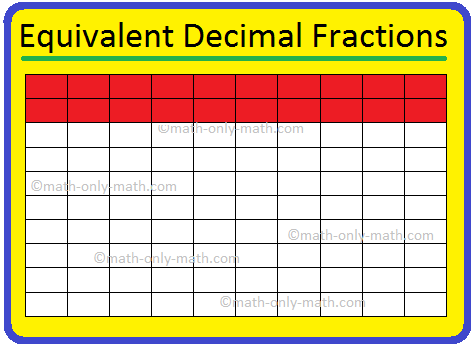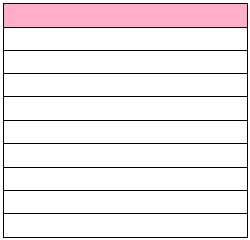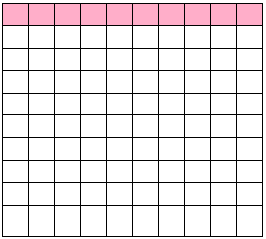Subscribe to our ▶️ YouTube channel 🔴 for the latest videos, updates, and tips.
Equivalent Decimal Fractions
Equivalent decimal fractions are unlike fractions which are equal in value.
Let us take a plane sheet which represents one whole. Now, we divide the sheet into 10 equal parts.
The colored part in the above figure represents two-tenths of the whole or 0.2.
We now further divide the part into 10 equal parts. There are now 100 equal parts.
The colored part in figure B represents the fraction \(\frac{20}{100}\) or 0.02. Same way, if we divide further there will be 1000 equal parts and the colored part will represent \(\frac{200}{1000}\) or 0.200. The decimals 0.2, 0.20 and 0.200 are equivalent decimals. So, placing any number of zeroes to the right of the decimal part does not change its value.
Look at the figures:
Both the fractions indicate the same shaded portions.
Therefore, we have 0.10 = 0.1
Similarly 0.20 = 0.2; 0.30 = 0.3
Let us consider the following examples:
(i) 0.4, 0.40, 0.400, 0.4000
Each of the above is equal to 0.4 or 4/10.
(ii) 1.9, 1.90, 1.900, 1.9000
Each of the above is equal to 1.9 or 19/10.
(iii) 10.14, 10.140, 10.1400, 10.14000
Each of the above is equal to 10.14 or 1014/100.
(iv) 0.94, 0.940, 0.9400, 0.94000
Each of the above is equal to 0.94 or 94/100.
(v) 9.1, 9.10, 9.100, 9.1000
Each of the above is equal to 9.1 or 91/10.
(vi) 60.49, 60.4900, 60.490
Each of the above is equal to 60.49 or 6049/100.
Similarly, we have
0.300 = 0.30 = 0.3
0.700 = 0.70 = 0.7
0.200 = 0.20 = 0.2
Thus,
by adding any number of zeros after the extreme right digit in the
decimal part of a decimal number does not change the value of the
number.
Numbers obtained by inserting zeros after the extreme
right digit in the decimal part of a decimal number are known as
equivalent decimals.
Hence, 0.75, 0.750, 0.7500 etc are equivalent decimals.
More Examples on Equivalent Decimal Fractions:
1. Is 0.90 = 0.9?
0.90 = \(\frac{90}{100}\) 0.9 = \(\frac{9}{10}\)
\(\frac{90}{100}\) = \(\frac{9 × 10}{10 × 10}\)
That is, \(\frac{90}{100}\) and \(\frac{9}{10}\) are equivalent fractions.
Therefore, \(\frac{90}{100}\) = \(\frac{9}{10}\)
Hence 0.90 = 0.9
2. Is 0.900 = 0.9?
0.900 = \(\frac{900}{1000}\) 0.9 = \(\frac{9}{10}\)
\(\frac{900}{1000}\) = \(\frac{9 × 100}{10 × 100}\)
That is, \(\frac{900}{1000}\) and \(\frac{9}{10}\) are equivalent fractions.
Therefore, \(\frac{900}{1000}\) = \(\frac{9}{10}\)
Hence 0.900 = 0.9
Similarly, 0.8 = 0.80 = 0.800 = 0.8000 and so on
0.7 = 0.70 = 0.700 = 0.7000 and so on
Adding one, two or three zeroes after the extreme right digit in the decimal part does not change the value of the fractional number.
For example:
0.25 = 0.250
0.46 = 0.4600
0.19 = 0.1900 and so on.
● Decimal.
Expanded form of Decimal Fractions.
Changing Unlike to Like Decimal Fractions.
Comparison of Decimal Fractions.
Conversion of a Decimal Fraction into a Fractional Number.
Conversion of Fractions to Decimals Numbers.
Addition of Decimal Fractions.
Problems on Addition of Decimal Fractions
Subtraction of Decimal Fractions.
Problems on Subtraction of Decimal Fractions
Multiplication of a Decimal Numbers.
Multiplication of a Decimal by a Decimal.
Properties of Multiplication of Decimal Numbers.
Problems on Multiplication of Decimal Fractions
Division of a Decimal by a Whole Number.
Division of Decimal Fractions by Multiples.
Division of a Decimal by a Decimal.
Division of a whole number by a Decimal.
Properties of Division of Decimal Numbers
Problems on Division of Decimal Fractions
Conversion of fraction to Decimal Fraction.
From Equivalent Decimal Fractions to HOME PAGE
Didn't find what you were looking for? Or want to know more information about Math Only Math. Use this Google Search to find what you need.






New! Comments
Have your say about what you just read! Leave me a comment in the box below. Ask a Question or Answer a Question.